Transportation is a major contributor to air pollution and greenhouse gas emissions, playing a significant role in health and climate challenges. Cars, trucks, buses, airplanes, and other vehicles release large amounts of harmful pollutants into the atmosphere. These emissions not only degrade air quality, impacting human health, especially in densely populated and underserved communities, but also accelerate climate change by trapping heat in the atmosphere.
With over 45 million people in the United States living, working, or attending school within 300 feet of a major road, airport, or railroad, concerns are rising about the health effects of traffic-related air pollution. As global travel and freight demand continue to rise, addressing emissions from the transportation sector is essential for building a cleaner, healthier, and more sustainable future.
What is air pollution composed of?
Air pollution is a blend of harmful substances released into the atmosphere from both human activities and natural processes and includes noxious gases (NOx), ozone, particulate matter (PM), volatile organic compounds, and polycyclic aromatic hydrocarbons (PAH).
Noxious gases
NOx forms when nitrogen and oxygen react at high temperatures, such as those found in combustion processes. During combustion, nitrogen in the air combines with oxygen to produce nitric oxide (NO), which can then react further with atmospheric oxygen to form nitrogen dioxide (NO₂). Together, NO and NO₂ make up nitrogen oxides (NOx). Primarily resulting from human activities, NOx emissions contribute to a variety of harmful effects, including the creation of ground-level ozone.
Ozone
Ozone, a gas found in the atmosphere, is commonly referred to as smog at ground-level.
Particulate matter
PM consists of chemicals like sulfates, nitrates, carbon, and mineral dust. The two most common are PM2.5 and PM10, or particles with aerodynamic diameters of 2.5 micrometers and 10 micrometers or less, respectively. PM2.5 accounts for most health issues from air pollution.
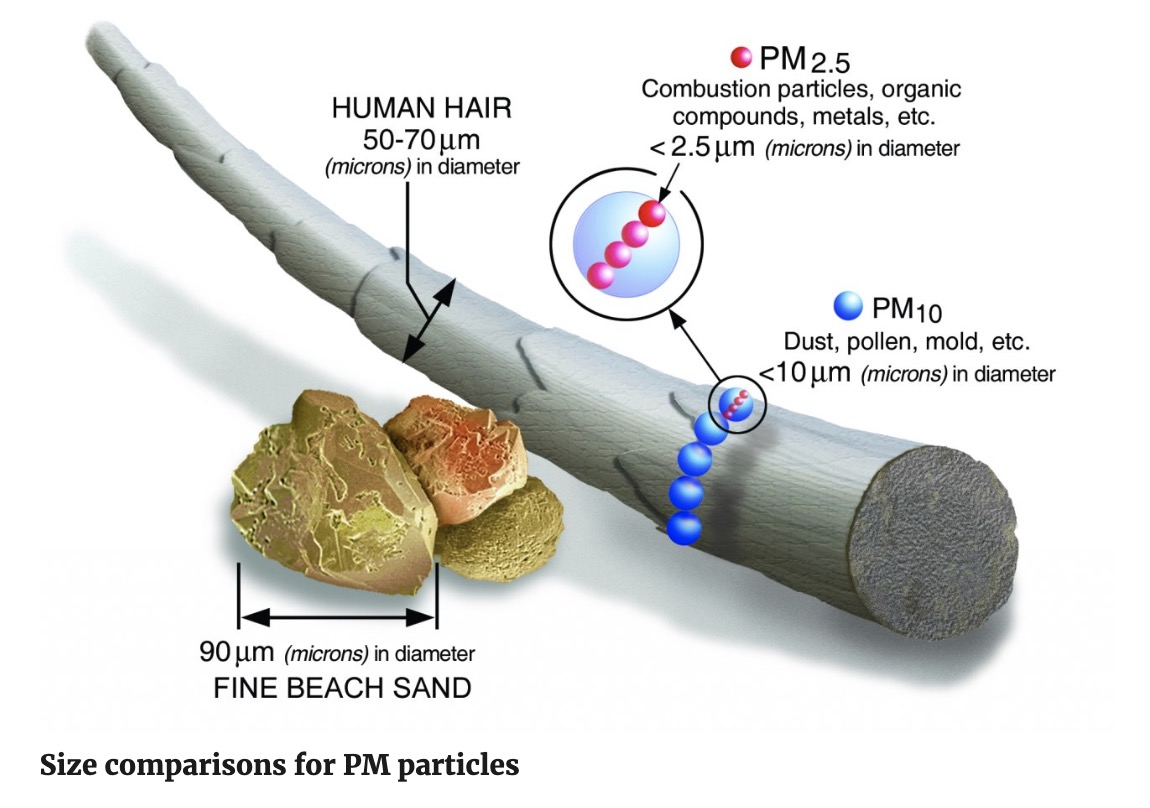
Volatile organic compounds
VOCs easily evaporate at or near room temperature, which is why they’re classified as “volatile.” They’re considered organic because they contain carbon.
Polycyclic aromatic hydrocarbons
PAH are organic compounds made up of carbon and hydrogen atoms. They are also commonly found in particulate matter.
Greenhouse gases
Greenhouse gases (GHG) are a component of air pollution but not the same as air pollution. GHG traps heat in the atmosphere and are important to keeping the Earth warm enough to sustain life. GHG includes water vapor (H₂O), carbon dioxide (CO₂), methane (CH₄), nitrous oxide (N₂O), hydrofluorocarbons (HFCs), perfluorocarbons (PFCs), and sulfur hexafluoride (SF₆). While water, carbon dioxide, methane, and nitrous oxide are naturally occurring, excessive amounts can cause dangerous levels of climate change. Climate change results in major changes in weather patterns, surface air and ocean temperatures, and sea levels.
The two major pieces of information we’ll focus on in this are noxious gases, carbon dioxide, and greenhouse gases as a result of transportation.
What contributes to air pollution?
Nearly all of the increase in atmospheric greenhouse gases over the past 150 years can be traced to human activities. Transportation is specifically a major contributor to air pollution and an over abundance of greenhouse gases.
The transportation sector is the leading source of CO₂ emissions in the United States, as more than 94% of the fuel used in transportation comes from petroleum sources, mainly gasoline and diesel. Highlights from the most recent Inventory of US Greenhouse Gas Emissions and Sinks report published by the US Environmental Protection Agency (EPA) in 2024 shows that in 2022, fossil fuel combustion accounted for 93% of carbon dioxide emissions, with transportation accounting for the majority of carbon dioxide at 35%.
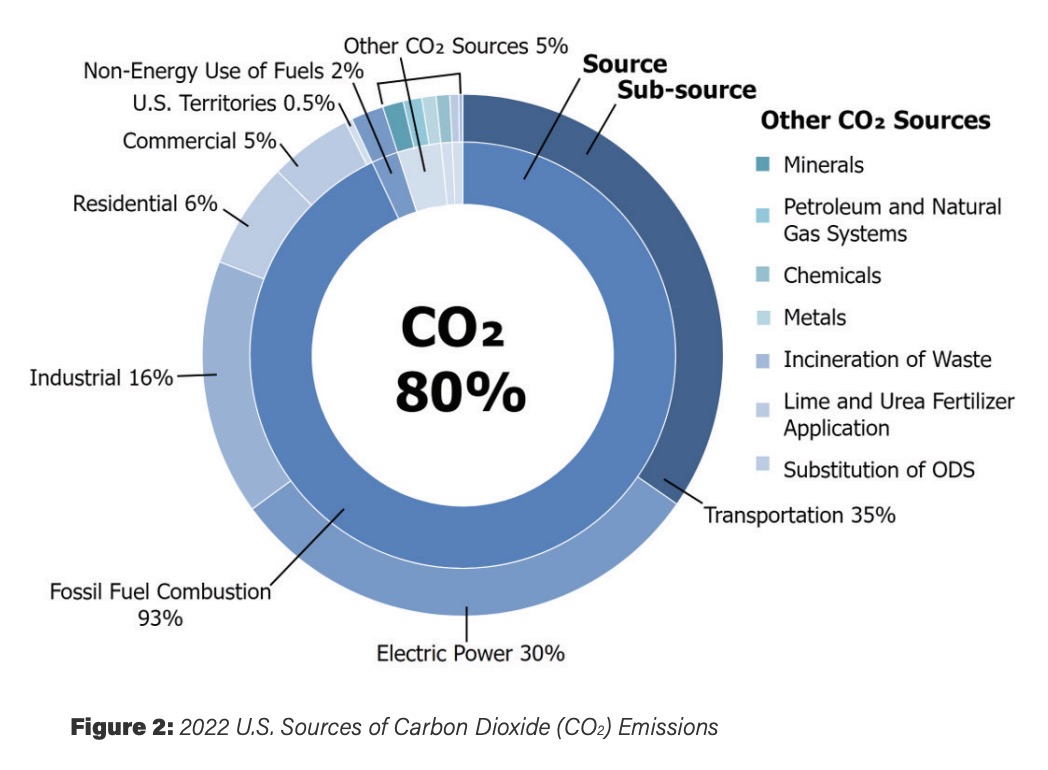
Additionally, according to the 2020 National Emissions Inventory, 45% of NOx emissions were a result of transportation in the US. Small amounts of methane and nitrous oxide are also released during fuel combustion, and hydrofluorocarbons are released through refrigerated transport.
Looking at just Illinois through the EPA’s interactive tool, it can be seen that fossil fuel combustion’s carbon dioxide has increased by 5.9% since initial data was collected in 1990. In Illinois specifically, though trucks, buses, and delivery vans make up just 7% of vehicles on Illinois roads, they produce 67% of smog-causing nitrogen oxide emissions, 59% of particulate matter (PM), and 36% of transportation-related greenhouse gases.
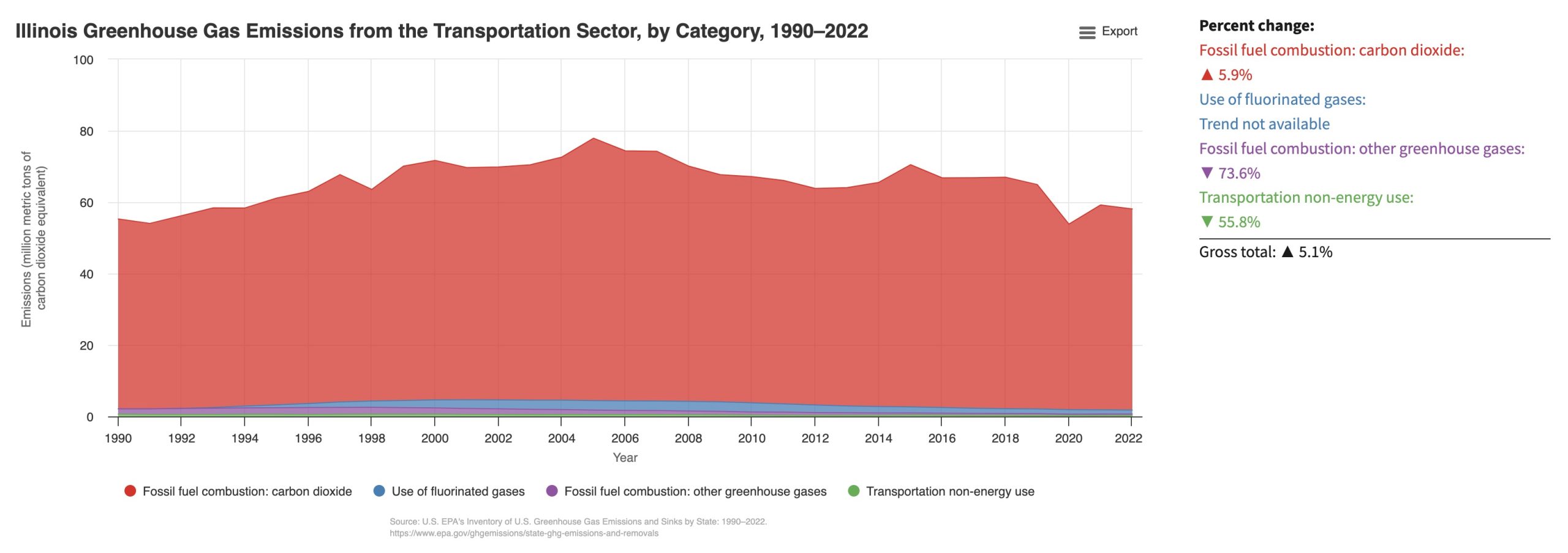
The report also shows that transportation accounted for the largest portion of US greenhouse gas emissions, at 28%. This equates to 5,489 million metric tons of greenhouse gases (discounting carbon sequestration from the land sector).
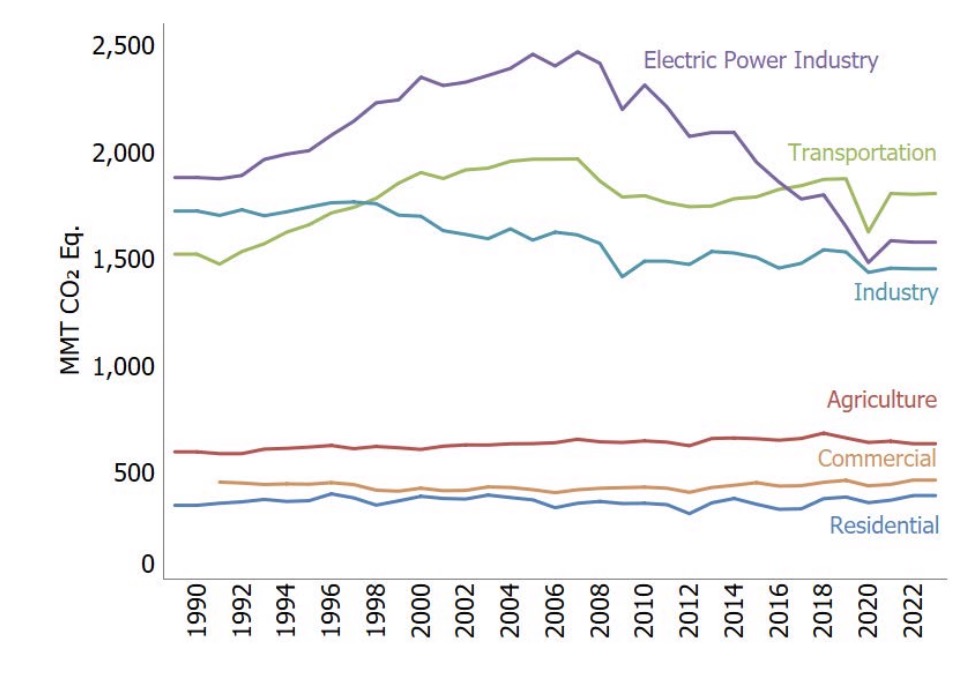
The largest sources of transportation-related greenhouse gas emissions were light-duty trucks, including SUVs, pickup trucks, and minivans at 36.5% of emissions. They were followed by medium- and heavy-duty trucks (22.9%), passenger cars (20.4%), commercial aircraft (7.2%), pipelines (3.8%), ships and boats (2.8%), other aircraft (2.0%), and rail (2.0%). When looking at the data collected by the EPA from 1990 through 2022, total transportation emissions from fossil fuel combustion has increased by 19.4%, mostly due to an increased demand for travel.
Traffic volume, wind speed, and wind direction greatly affect pollutant levels. Emissions near major roads come from vehicle exhaust, fuel evaporation, tire wear, and road dust. Pollutant levels are influenced by factors such as traffic volume, vehicle type, fuel used, wind conditions, and terrain. While more traffic typically leads to higher emissions, stop-and-go driving and congestion can further increase certain pollutants. Pollution levels are often highest during rush hours and when wind conditions are calm. Other influences include the types of vehicles on the road, roadway design, and surrounding land use.
What are the effects of air pollution on health?
Outdoor air pollution is a significant health threat that impacts people across all incomes in every country. According to the World Health Organization (WHO), air pollution is the second highest risk factor for noncommunicable diseases and reducing it is vital to protecting public health. It has been linked to oxidative stress and inflammation in human cells, processes that can contribute to the development of chronic diseases and cancer. In 2013, the International Agency for Research on Cancer classified air pollution as a human carcinogen.
More specifically, a large study involving over 57,000 women found that living near major roadways may increase the risk of breast cancer and that occupational exposure to benzene—a chemical found in gasoline—has been linked to leukemia and is associated with non-Hodgkin’s lymphoma. Additionally, research using national data on older adults showed that long-term (10-year) exposure to PM2.5 and NO₂ is associated with increased risks of colorectal and prostate cancers.
Other negative health effects include heart disease. Fine particulate matter has been shown to impair blood vessel function and accelerate the calcification of arteries, which can lead to heart attacks and other cardiovascular diseases. Additionally, for some older adults, exposure to traffic-related air pollution (TRAP) can reduce levels of high-density lipoprotein (HDL), or “good” cholesterol, raising the risk of cardiovascular disease.
Air pollution also affects the lungs. In a national study involving 50,000 women, long-term exposure to PM2.5, PM10, and nitrogen dioxide was linked to an increased risk of chronic bronchitis. It interferes with lung development and has been linked to respiratory conditions such as emphysema, asthma, and chronic obstructive pulmonary disease (COPD).
A report from the National Toxicology Program (NTP) also found that traffic-related air pollution (TRAP) exposure during pregnancy increases the risk of hypertensive disorders, dangerous changes in blood pressure that can lead to preterm birth, low birth weight, and serious maternal and fetal health complications.
Other serious risks as a result of air pollution are birth defects, developmental delays, dementia, respiratory infections, diabetes, obesity, and other reproductive, neurological, and immune system issues.
Most severely, air pollution causes premature death. According to WHO, in 2019, ambient air pollution in urban and rural areas was estimated to cause 4.2 million premature deaths globally each year. These deaths are primarily linked to exposure to fine particulate matter. Approximately 68% of these premature deaths were caused by ischemic heart disease and stroke, 14% by chronic obstructive pulmonary disease, 14% by acute lower respiratory infections, and 4% by lung cancer.
In a report from 2022, it was expected that Illinois would rank fifth among all states for the highest per capita deaths caused by PM2.5 pollution from diesel engines the following year. Although Illinois makes up about 4% of the U.S. population, its residents will account for 6.3% of asthma-related emergency visits and 5.3% of non-fatal heart attacks linked to diesel PM2.5 pollution nationwide. Additionally, the state’s most polluted counties rank among the top 9% worst polluted counties in the country.
Each year, diesel engine exhaust is linked to an estimated 416 premature deaths, 24,601 lost workdays, and $4.6 billion in costs related to health impacts in Illinois. Residents bear the burden of diesel pollution through medical expenses, costly medications, and missed work or school days.
Who is the most affected by air pollution?
Globally, nearly 9 out of 10 people living in urban areas are exposed to harmful air pollution. In the US, more than 45 million people reside within 300 feet of major transportation corridors, raising significant concerns about their long-term exposure to harmful air pollutants from vehicles.
The effect of air pollution on public health
People living within 100 meters of a major roadway face a 42% higher risk of ischemic stroke compared to those living more than 400 meters away. In some areas, neighboring ZIP codes show life expectancy differences of 10 to 12 years. Even short-term exposure to elevated levels of outdoor air pollution can cause reduced lung function, asthma flare-ups, heart problems, increased emergency room visits, and hospital admissions.
The health risks polluted air poses is especially concerning for individuals with existing health conditions or more vulnerable respiratory systems, such as children, pregnant people, and older adults, and those living near busy roads and transit hubs.
Children
The National Institute of Environmental Health Sciences (NIEHS)-funded Children’s Health Study at the University of Southern California is one of the largest studies on how air pollution affects children’s respiratory health. It found that higher pollution levels lead to more respiratory infections and school absences, and children living near busy roads or in high-ozone areas, especially those active in outdoor sports, are more likely to develop asthma.
Rising asthma rates and severity have been associated with urbanization and increased outdoor air pollution, with children in low-income urban areas experiencing disproportionately high rates of asthma. It has been found that exposure to ozone and PM2.5 is associated with airway changes related to asthma in children and each year, an estimated 4 million children in the US develop asthma due to living near roadways. Exposure to air pollution in childhood is also linked to bronchitis symptoms in adulthood and long-term lung damage.
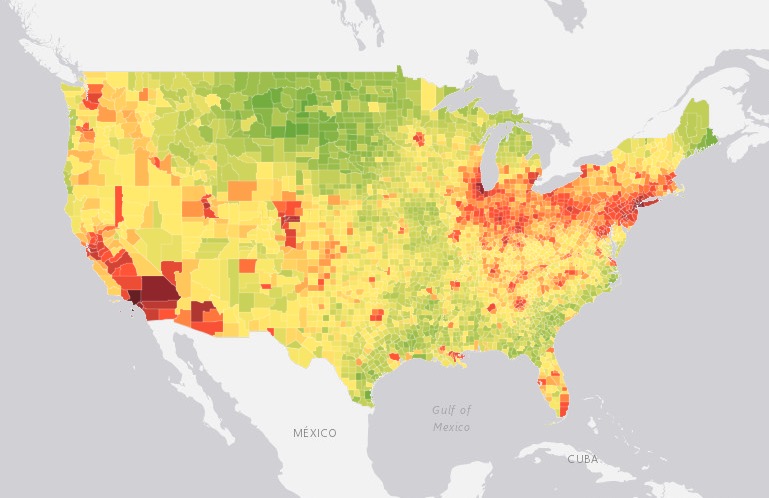
Pregnant individuals and fetuses
Even at low levels, exposure to fine particulate matter during pregnancy can impact a child’s brain development, increasing the risk of cognitive, emotional, and behavioral problems, including ADHD and autism. Studies have also linked prenatal exposure to PM2.5 and PAHs with cerebral palsy, low birth weight, and high blood pressure in early childhood. Additionally, long-term exposure to PM2.5 and ozone before and after birth may increase the risk of postpartum depression.
Elderly
Air pollution, especially fine particulate matter, has been linked to an increased risk of Alzheimer’s, Parkinson’s, and other dementias. NIEHS-funded studies found that exposure to pollution from sources like traffic, agriculture, coal, and wildfires raises dementia risk, while improved air quality can lower it—equivalent to reducing biological age by nearly 2.5 years in older women. Long-term exposure to PM2.5 and carbon monoxide is also associated with Parkinson’s disease. Additionally, high pollution levels have been linked to bone loss in postmenopausal women.
Race, ethnicity, and socioeconomic disparities
Research reveals racial, ethnic, and socioeconomic disparities in exposure to air pollution. Although overall emissions have decreased in recent decades, the reductions have not been shared equally.
Race is a stronger predictor of exposure to toxic pollution than income. Disproportionately, non-white populations face higher exposure to hazardous fine particle pollution from nearly all major US emission sources, regardless of location or income. People living in poverty experience 35% more air pollution than the average American, while non-white individuals are exposed to 28% more. Black communities face the highest burden, with exposure levels 54% above the average.
The effects of climate change on public health
While air pollution has a direct effect on public health, greenhouse gas emissions’ effect on the climate causes its own set of health issues. These are more drastic in certain social and economic situations. By 2050, researchers estimate that ozone and particle pollution could contribute to 1,000 to 4,300 additional premature deaths each year in the United States if current regulations and population trends remain unchanged.
The state of Illinois has seen notable shifts in weather patterns over the past 120 years, with increases in air temperature and precipitation across all seasons since the early 1900s. The climate changes seen in Illinois since the early 20th century are mainly caused by human activities, especially the rise in heat-trapping greenhouse gas emissions like carbon dioxide and methane. The changing climate is expected to continue evolving throughout this century, bringing significant impacts to both urban and rural communities across the state. These changes have heightened the risk of extreme weather, which has an effect on water and food availability, the spread of disease, and mental health.
Extreme weather
Climate change is increasing the frequency and intensity of extreme weather events, threatening health and safety. Rising temperatures in Illinois are causing heat waves to become more intense and frequent. Prolonged periods of high daytime and nighttime temperatures, especially when combined with high humidity, can trigger a range of heat-related illnesses.
Throughout the state, average daily temperatures have risen by 1 to 2 degrees Fahrenheit, with overnight lows increasing more than daytime highs. Seasonal warming varies: winter and spring temperatures have climbed 2 to 3 degrees, while summer temperatures have changed little since the early 20th century.
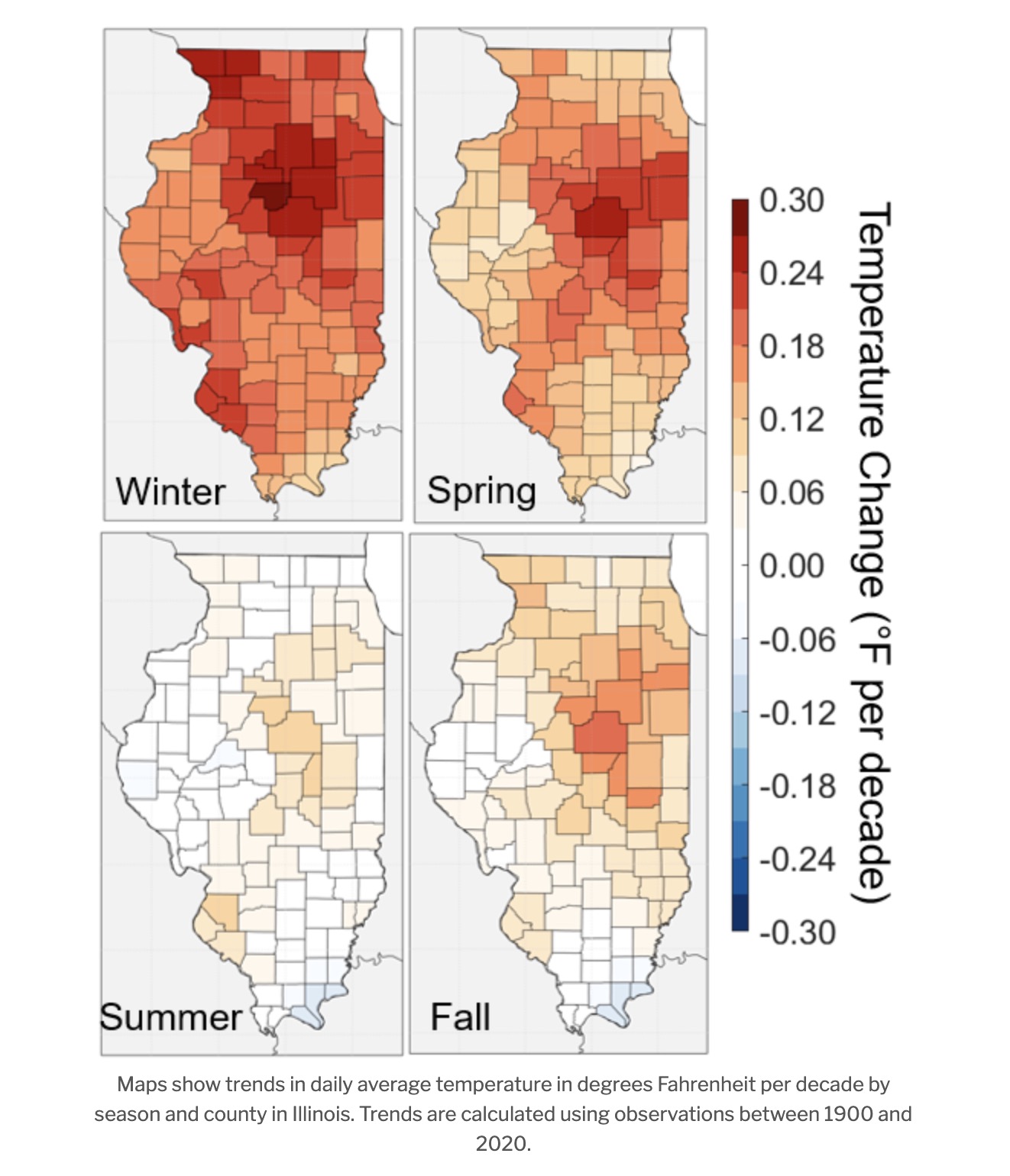
Those most vulnerable include older adults, people with chronic health conditions or mental illness, individuals living alone, and those without access to or unable to afford air conditioning. Outdoor workers performing physically demanding tasks are also at increased risk of heat exhaustion and heat stroke.
On a per capita basis, residents in some rural areas of Illinois face a higher risk of hospitalization due to heat-related illness compared to those in urban settings. Contributing factors include greater exposure to heat, a higher proportion of elderly individuals, longer distances between homes and medical facilities, and limited access to transportation and cooling centers.
In Illinois’ urban areas, rising temperatures from climate change, intensified by the urban heat island effect, could push temperatures to record highs in neighborhoods with little greenery. This combination significantly raises the risk of heat-related illnesses in already at-risk communities.
The effects of greenhouse gases also more drastically affect certain social and economic groups. These groups have higher rates of chronic illnesses that climate change worsens. Additionally, people with disabilities or chronic conditions may experience disrupted medical care during emergencies, and mobility or sensory impairments can limit access to safety and healthcare.
Additionally, precipitation has risen throughout Illinois, with total annual rainfall increasing by 5 inches over the past 120 years—an increase of about 12 to 15%. Precipitation has also become more intense, with the number of days receiving 2 inches or more of rain in Illinois increasing by 40% since the early 20th century. Increased precipitation and more frequent heavy rainfall are expected to elevate public health risks from flooding across Illinois. Flooding promotes mold growth, while longer pollen seasons due to climate change raise the risk of allergies and asthma attacks.
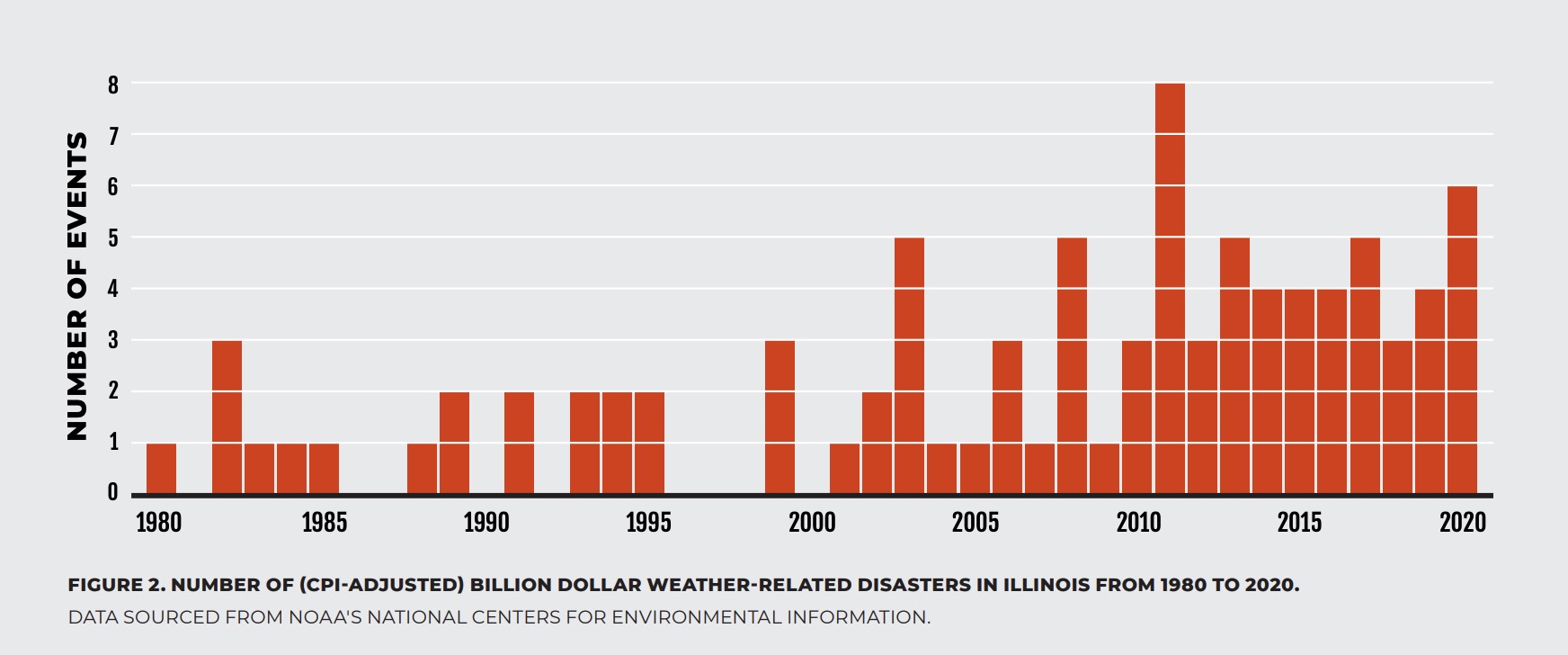
Communities with combined sewer systems, such as Chicago, are especially vulnerable, as intense rainfall can cause sewer overflows into surface waters. This has been linked to higher rates of diarrheal illness, particularly among children. Flooding can also disrupt the operations of health care facilities, potentially limiting access to critical services. In Illinois, dozens of health care facilities are situated within mapped floodplains, making them vulnerable to reduced accessibility or shutdown during flood events.
Illinois is projected to experience rising air temperatures and increased precipitation throughout the 21st century. By the century’s end, average daily temperatures are expected to rise between 4 and 9 degrees Fahrenheit under a lower emissions scenario, and between 8 and 14 degrees under a higher emissions scenario. This warming will likely lead to more frequent extreme heat events and fewer extreme cold days. While overall precipitation is expected to increase, changes in its timing and intensity are anticipated, with heavier rainfall and longer dry spells becoming more common. Additionally, hotter summers are projected to worsen and accelerate drought conditions across the state.
Droughts can also cause respiratory issues from dust, while storms and floods lead to injuries, property damage, and waterborne infections. These events can also disrupt access to medical care, especially for vulnerable groups like older adults, pregnant women, and those with chronic illnesses. Rising temperatures heighten risks of heat-related illnesses, and extreme heat is now the leading cause of weather-related deaths in the US.
Water and food
Climate change has an effect on the availability of food and water. It worsens water, food, and air quality, causing harmful algal blooms, water contamination, drought, and reduced drinking water.
Changes in climate also affect crops, pests, and food safety, making it harder for some to access nutritious food. Longer growing seasons may benefit some farmers, allowing for more crops, but also require more irrigation and increase heat stress. Ground-level ozone harms crops by reducing growth and increasing disease risk. Rising temperatures also expand the range of pests and diseases and can disrupt pollination. Livestock face reduced productivity due to heat and humidity.
Soil and water resources are also under threat. More frequent heavy rains erode soil, wash away nutrients, and increase runoff that pollutes waterways. Combined with warmer water, this can lead to hypoxia, killing fish and shellfish. Coastal farms face additional risks from sea level rise, erosion, and saltwater intrusion.
Insects and tick-related diseases
Illinois’ warmer and wetter climate has already allowed mosquitoes and ticks to thrive in areas where they previously couldn’t survive.
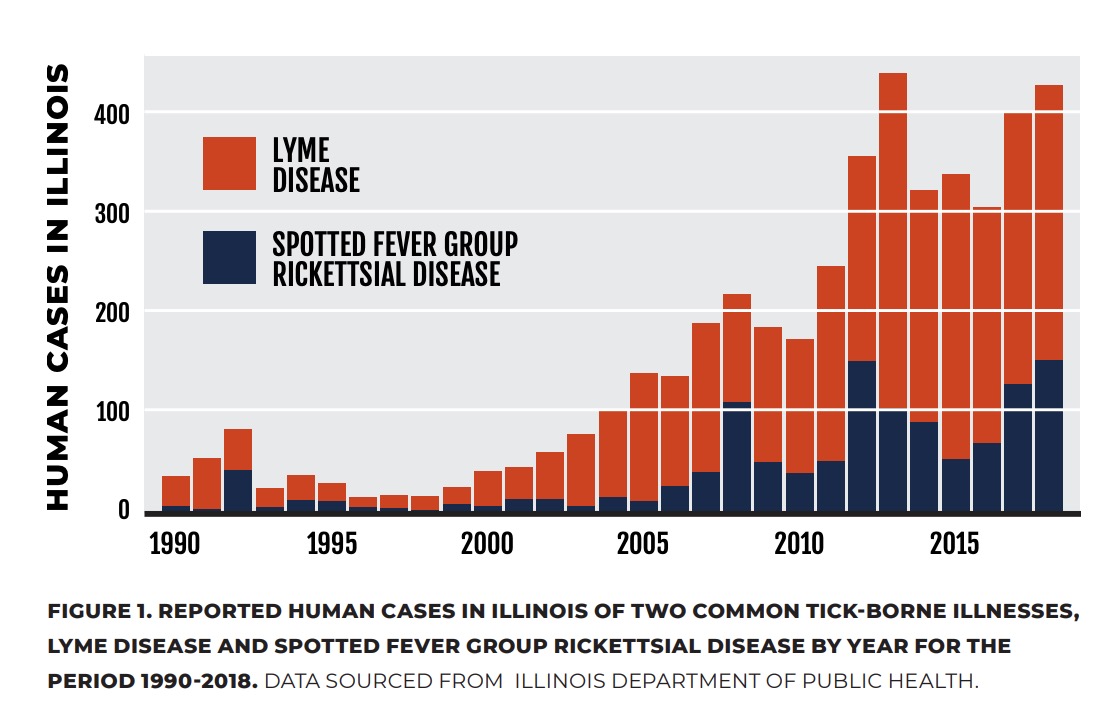
Rising temperatures have extended their biting season, and this trend is expected to continue, heightening the risk of vector-borne illnesses such as Lyme disease and West Nile virus. Climate change is a key factor in this rise. For instance, milder winters, which are becoming more common with climate change, have been linked to outbreaks of West Nile virus.
Mental health and well-being
Climate change greatly affects mental health and well-being. Extreme weather events such as floods, droughts, and heatwaves can cause emotional distress and trauma, leading to various mental health disorders, such as depression, anxiety, and post-traumatic stress. Climate-related disasters are especially traumatic for children, causing loss of stability, community, and sometimes homes. Flood-affected households often report elevated anxiety and depression that lasts years. Additionally, natural disasters, especially heat and droughts, can increase tobacco and alcohol use, as well as violence.
Illinois farmers and farm workers face heightened mental health risks due to climate change. Factors like long work hours, heavy workloads, financial pressures, and dependence on weather contribute to these challenges. Compounding the issue, rural Illinois has limited access to mental health care, with some of the highest population-to-provider ratios in the nation.
Why alternative fuels are essential in reducing air pollution and greenhouse gases
Switching to alternative fuels and cutting down dependence on fossil fuels for transportation is crucial for a cleaner, healthier, and more affordable transportation future. Alternative fuels help reduce harmful emissions, improve air quality, stabilize fuel costs, and strengthen energy security, offering many important benefits.
Transforming transportation is also essential to tackling climate change. Evidence from natural records like ice cores, rocks, and tree rings, combined with modern tools such as satellites and instruments, all point to a changing climate. According to NASA, although Earth’s climate has fluctuated over time, the current rapid warming, driven by human activities since the mid-1800s, is unprecedented in the past 10,000 years. Rising global temperatures and melting ice sheets clearly demonstrate the reality of a warming planet.
To limit warming below 2°C, replacing gasoline and diesel with low-carbon fuels is essential. Electric power from renewables, biodiesel, ethanol, renewable propane, natural gas, renewable diesel, or renewable hydrogen all have a role to play in replacing gasoline and diesel vehicles on the road, depending on use case.
More specifically, biofuels, or those derived from plants and algae, are nearly carbon-neutral since they release only the carbon absorbed by their source crops and reduce emissions in traditional engines. Biodiesel is non-toxic and biodegradable, while ethanol and renewable diesel are less toxic and biodegradable. Using CNG or LPG also cuts CO2 emissions and poses minimal environmental risk if spilled, as they quickly evaporates.
Additionally, prioritizing rapid urban transit, walking and cycling networks in cities as well as rail interurban freight and passenger travel and planting trees and greenery also help with reducing emissions and cleaning the air.
While data from the US EPA shows that Illinois has reduced emissions from transportation by 25% between 2005 and 2022, there is still a long way to go, as the transportation sector still makes up the largest share of greenhouse gas emissions in Illinois. Diesel was once the only option, but now technology helps protect Illinois communities from deadly diesel pollution. Strong rules are needed to speed up the switch to zero-emission trucks, buses, and vans. Though only 7% of vehicles, these trucks and buses produce most smog, particulate matter, and greenhouse gases from transportation.
Reducing air pollution and impeding climate change is vital to improving public health
Extreme heat, heavy rainfall, and flooding have already impacted, and will continue to impact, infrastructure, human health, agriculture, forestry, transportation, as well as air and water quality. Climate change will also intensify various risks facing the Great Lakes.
Reducing emissions from the transportation sector is essential to protect public health and combat climate change. As traffic-related air pollution continues to impact millions, especially those living near major roads and transit hubs, advancing cleaner transportation solutions is critical.
Alternative fuels are more common than many people realize, with several proven options already available. As technology improves and infrastructure grows, using alternative fuels will be key to reducing climate change, improving public health, and promoting long-term sustainability. Choosing cleaner transportation solutions now sets the stage for a more resilient and environmentally responsible future.

Whitney began working with IACT in 2023. With a degree in English and a minor in Art, Whitney has worked as both a newspaper reporter and a digital marketing and events manager, bringing 7 years of marketing and 8 years of content creation experience to IACT. Whitney is passionate about nature and preserving the environment, including solutions to cleaner air and greater sustainability, and is a former Chicago resident.



